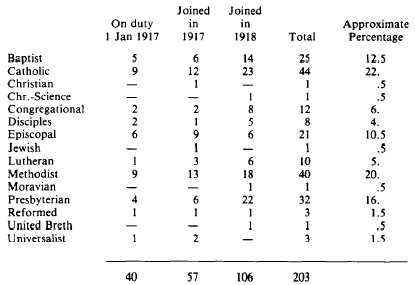Religion has always had particular significance for those who ventured
forth upon the sea. Chaplains have been assigned to ships since the origin of
the Continental Navy. Faced with the necessity of producing a set of
governing rules for the Continental Navy, it was natural that Congress
should turn to the British Navy for a model. Due consideration was thus
given to divine services and to the placing of chaplains on the new Continen-
tal Navy’s larger vessels.
By 1881, the majority of Navy chaplains had been drawn from the faith
groups listed in figure 2-1. With immigration rapidly changing the religious
makeup of the United States, the time came when other churches requested
The number of men who are known to have
served in the United States Navy as chaplains till
1881 total 159, of which 58 were not ordained. The
classification of the ordained men by denomina-
tions is as follows: Baptist, 12; Congregational, 7;
Methodist, 22; Episcopal, 42; Presbyterian, 14;
Unitarian, 3; and Universalist, 1. Since the total is
101, the figures given show the approximate per-
centage. Two denominations, the Methodist and
the Episcopal, furnished about two-thirds of all
ordained naval chaplains for the first eighty years of
the Navy’s history.
As was to be expected, the time came when other
churches requested the privilege of having some of
their clergymen commissioned as chaplains.
Figure 2-1.—Ecclesiastical Composition of the U.S. Navy
Chaplain Corps from its inception till the year 1881.
Figure 2-2.—Ecclesiastical Composition of the U.S. Navy Chaplain Corps in 1918 at the close
of World War I.
2-2


